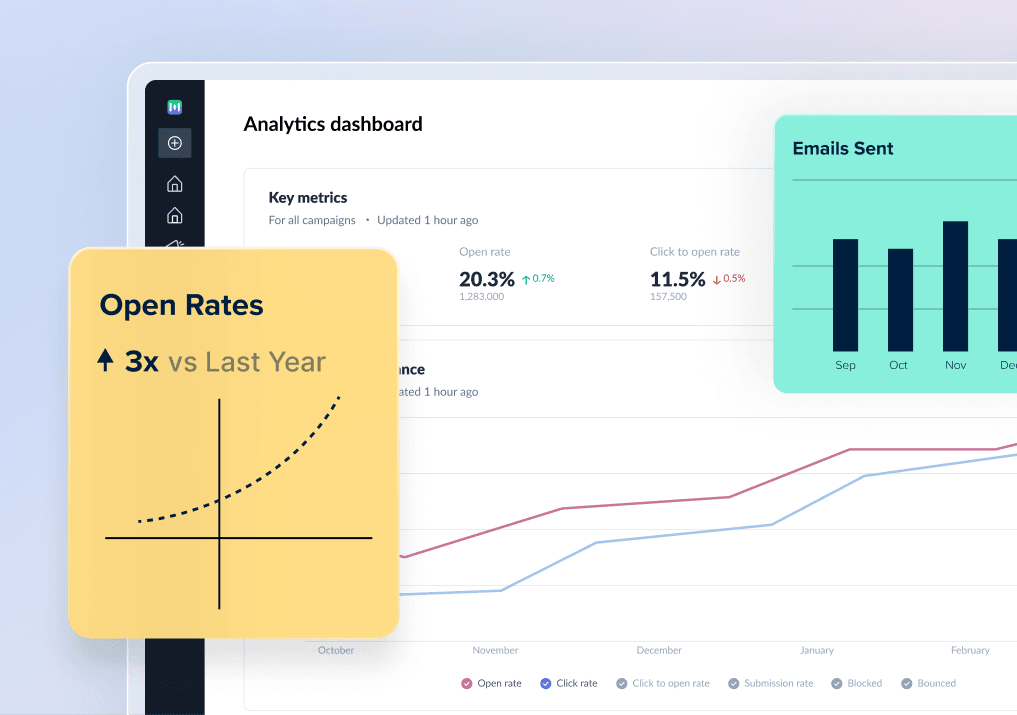You might need a more precise picture if you feel insurance email marketing is dead for your business. Whether you fail to engage policyholders and convert leads to customers, insurance email marketing can still save you a lot of investment and provide the best returns.
It allows you to be more direct with your customers, build better relationships and automate for the best response. This guide will help you with the benefits, tips and best practices of insurance email marketing.
Table of contents
10 Best Practices for Insurance Email Marketing
- 1. Stay informed about insurance email regulations.
- 2. Use double opt-in confirmation for subscription
- 3. Email list segmentation
- 4. Create persuasive subject lines
- 5. Personalize your emails
- 6. Set up behavioral triggers
- 7. Test your emails
- 8. Regularly analyze campaign performance
- 9. Be consistent with your newsletters
- 10. Improved Engagement Through AMP Mails
What is insurance email marketing?
When insurance agents or companies send emails to their targeted policyholders or prospects, they engage in this process called insurance email marketing. The core objectives of this marketing strategy is to promote insurance products, share important information.
In simpler words, insurance email marketing is a tool or method that allows insurance companies to connect with their existing customers, and reach potential customers via the medium of email.
What challenges do insurance agents face?
The experience of being an insurance agent can be subjective. Building trust might be easy for one and difficult for another. Here, we have mentioned the five key challenges insurance agents face.
1. Getting marked as spam
Most customers avoid opening promotional emails. When you keep sending them unrequired email content, they may mark your email as spam or even block you on emails.
2. Educating new customers about insurance
If you pitch to a new customer, they might be unaware of the complex insurance-related terms. Some of them might never understand the benefits of having insurance. In that case, you must create informative email content to change their minds.
3. Retaining policyholders
The insurance industry is highly competitive. When you underestimate the value of your loyal customers, some other insurance agent is there to serve them. Hence, you need to stay in touch with them. You can do that by providing newsletters, policy updates and discounts.
4. Understanding customers' needs and preferences
Generic emails often get ignored by customers. Many insurance agents treat their customers as numbers and contacts. They don't understand the customer's likes and dislikes. Besides, they focus highly on transactional needs but don't try to make their businesses more engaging.
With platforms like Mailmodo, you can get valuable insights to create segmented and personalized emails.
9 types of insurance emails to send
Emails for insurance marketing can be slightly different from other categories. Insurance companies add testimonials and provide comprehensive guides on how to choose the right policy. They also send content that educates them on the need to have a good policy. Here are the 10 insurance emails you can send your customers.
1. Welcome emails
You must use an email marketing tool to build a "Welcome email" template for your new customers. This way, you can connect to your customers by sending them a warm welcome or a simple "Thanks for visiting our website" email.
In this email, you can elaborate on what your customers should expect from your insurance services. You can also motivate them to explore another product or service of yours.
2. Newsletters for educational purposes
Create educational newsletters to provide information about insurance-related topics. You can add something as simple as "Myths And Facts of Health Insurance" or "Health Insurance to cover pre-existing diseases."
Additionally, you can create a data-based report or a guide to help your customers buy genuine insurance.
3. Policy updates
These insurance emails are usually sent only to old customers. You can send them if there are any changes or modifications to their cover. For example, create an AMP mail about "Get additional cover up to 5 lakh by adding INR 500 annually."
Moreover, you can inform them about changes in conditions or terms, coverage of chronic diseases, etc.
4. Reminder emails
Keep sending renewal reminders to customers a week before their renewal dates. Wait until they decide to renew or inform about the surrender or exit from the policy. You can also upsell other relevant products in these emails.
Your reminder email should have a policy name, amount payable, username and expiry date. You can personalize your emails and include renewal benefits to influence your customers.
5. Claims process guide
Making customer journeys simpler is a key to profitable business. You can include a step-by-step guide for filing insurance claims. You can collect their queries using surveys and forms.
With AMP emails, you can make conversations more interactive without customers having to visit your website.
6. Product recommendation emails
You can recommend new insurance products or coverage options using product recommendation emails. In this way, you can cross-sell and upsell multiple products in a single email.
You can add offers like bundling policies or multiple products in these emails for better customer savings.
7. Seasonal greetings
You can personalize your emails to send greetings on birthdays and festivals. It could be a simple greeting like "Happy Birthday" or a "Happy International Doctor's Day."
Sending these greetings prompts customers to appreciate your effort and take action.
8. Milestone emails
You can send these emails to celebrate events or achievements in a customer's insurance journey. It can be about policy anniversaries, successful claims, or policy updates.
These emails can strengthen your relationship with the policyholder, making them feel valued and appreciated.
9. Feedback and survey emails
Feedback and survey emails are sent after your interaction with customers. These messages aim to gather opinions, insights and feedback about their experience. It could be a form, questionnaire or a survey to share their thoughts.
These emails can act as post-nurture emails. Once you have built trust and loyalty with customers, you can understand customers' pain points and use their insights to make your processes more efficient.
4 Benefits of insurance email marketing
Email marketing for insurance has several benefits. Here are the four key benefits of insurance email marketing:
1. Affordability
Email marketing for insurance is economical compared to traditional marketing methods such as radio, TV, billboards or print advertising. With low up-front costs, you can send emails to a large audience without spending a fortune.
This cost-effectiveness is especially beneficial for small and medium-sized enterprises (SMEs) with constrained marketing budgets.
2. Personalized communication
What makes email marketing unique is its ability to send highly personalized messages. With email marketing tools, you can craft compelling emails using data like behaviors, preferences and demographics, thanks to its insights.
Personalization builds a deeper connection with your audience, making recipients feel valued and understood.
3. Quick communication
Unlike traditional methods, you can share your businesses quickly and efficiently. Email marketing is straightforward and doesn't require lengthy production and distribution processes.
You can instantly send emails within minutes of important announcements, updates or promotions.
4. Measurable results for optimization
You can get relevant insights into campaign performance. The easy tracking of metrics like click-through rates, open rates and conversion rates facilitates you to make informed decisions.
Once you have all the essential data, you can use it to improve your email marketing strategy for better results.
💡 Related guide: 15 Brilliant Email Marketing strategies for winning campaigns
10 Best Practices for Insurance Email Marketing
From being aware of insurance email regulations to the utilization of AMP emails, here are the 10 best practices for insurance email marketing.
1. Stay informed about insurance email regulations.
Before starting an email insurance campaign, it is crucial to be aware of insurance industry regulations. You must comply with laws like CAN-SPAM and GDPR to avoid potential legal concerns and maintain the goodwill of your customers.
Here are a few key points that you should understand:
CAN-SPAM stands for the Controlling the Assault of Non-Solicited Pornography And Marketing Act of 2003. This law was passed in 2003, setting up the United States' first national standards for sending commercial emails.
According to the CAN-SPAM Act, your commercial email should have an opt-out mechanism and a physical postal address.
GDPR(General Data Protection Regulation) is a European regulation that governs personal data processing, including email addresses.
In the European Union (EU), you can not send customers marketing emails without explicit consent. Besides, you must inform them that their data will be used and allow them to unsubscribe anytime.
Additionally, you must take care of record keeping, data security, permission-based marketing and regular compliance checks to improve your email marketing process.
2. Use double opt-in confirmation for subscription
In double opt-in confirmation, your customers must confirm their signup before you email them. You can use a button with something like "Confirm email subscription" or "Authenticate email". A double opt-in confirmation ensures you only get access to genuinely interested customers.
When you know that you have a genuine list of emails, you can ensure quality control and improve engagement. Some of the key benefits of double opt-in confirmation are:
Improved email list
Better engagement
Enhanced deliverability
Less spam rate
3. Email list segmentation
To improve subscriber rates and customer retention, email segmentation is the first resort. Email segmentation is about delivering highly targeted emails by dividing customers based on criteria like geography, age, buying history etc.
It gives results because when you send a relevant email to a specific group of customers, you can engage with them. In this way, you can encourage your customers to engage and buy your insurance products.
While static lists can provide you with the people who opt-in for your emails, dynamic lists are used for understanding the buyer's journey. With Mailmodo's dynamic segmentation, you can nurture your email campaigns, retain customers and hyper-personalize your content.
💡 Related guide: 12 Email Segmentation Strategies to Send Highly Targeted Campaigns
4. Create persuasive subject lines
Email subject lines decide whether your email will be spam or a lead. While your subject line needs to be hooking, it shouldn't sell anything. As an insurance agent, you must ensure that your subject line should be clear and easy to read.
With hundreds of monthly emails, you can not drain your creative juices for an email subject line. Therefore, you can use an AI tool like Open Higher for better engagement and email open rates.
This way, you can personalize your email content, keep it simple and get decent results.
5. Personalize your emails
The key objective of email marketing is to provide a more personalized experience. With AI tools, you can collect data, analyze it and integrate it with your ESP. Your ESP can help you automate emails. This way, you can save your and your customer's time and enhance productivity.
With improved personalization, you won't have to make many insurance sales calls. Besides, understanding their pain points and interests can help you create a better insurance email marketing strategy.
💡 Related guide: An Email Personalization Guide to Strengthen Customer Relationship
6. Set up behavioral triggers
Behavioral triggers emerge when someone comes to your website, abandons their cart, buys a product or performs any activity. They automate the email marketing process. New users might receive a welcome email, while recent buyers might get product recommendations or post-nurture emails in their inboxes.
Behavioral triggers are based on customer journeys. Since different customers have different requirements, emails are automated using ESP to provide a more personalized experience.
For instance, when someone visits your website and adds items to the cart but leaves without completing the purchase, you can send an automated email to remind them about the abandoned cart. Leaving the cart is a behavioral trigger, and the automated email is a behavior trigger email.
7. Test your emails
With A/B testing, you can test different versions of your emails within your audience to find out which works best. When you get a copy with better open rates and click-through rates, you can pick it as your final copy.
Your email copy's performance is based on metrics like return on investment (ROI), click-through rates, conversions and unsubscribe rates. Later, you can use these metrics to enhance your email marketing strategy.
With Mailmodo's A/B testing, you can catch the rendering issues before you send emails. This ensures that your messages have a good email design and are effective when received by customers.
💡 Related guide: How to Set Up Email A/B Testing to Improve Email Performance
8. Regularly analyze campaign performance
Understand the significance of email marketing metrics. Everything plays a crucial role in a campaign's performance, from open-rates to unsubscribe-rates.
Platforms like Mailmodo enable email marketers to analyze their email campaigns based on metrics and design. With data-driven insights, you can make informed decisions to revamp your email marketing strategy.
You get better campaigns when you constantly monitor and optimize your email campaigns, leading to strong customer relationships.
9. Be consistent with your newsletters
You must choose a suitable time and frequency for your email newsletters to maintain your audience's interest. Once you have finalized your newsletter dates, stick to it for a while and observe the results.
Usually, it is advisable to send newsletters on weekdays. Your newsletters can be monthly, bi-weekly or weekly, depending on your company's requirements. On the other hand, sending too many newsletters might lead your emails to spam folders.
💡 Related guide: How to Create a Newsletter - A step-by-step guide
10. Improved Engagement Through AMP Mails
The arrival of AMP (Accelerated Mobile Pages) emails took the marketing revolution to a new level. AMP emails allow you to interact with customers without leaving the inbox.
With AMP emails, you can provide customers with an excellent user experience and boost conversion rates. You can add a real customer story to make your emails credible.
Pro tip: When you share emotionally-driven testimonials in your emails, customers engage as they can relate to that situation.
However, these testimonials shouldn't be salesy or highly emotional as it might lead customers to mark you as spam.
Wrapping up
Insurance email marketing comes with a lot of benefits. As an insurance email marketer, you have to make a sale and create a sustainable process to re-engage your customers.
With hundreds of customers onboard, email automation is the only way to write newsletters and send hundreds of welcome emails daily. You can use the above best practices and tips to boost your sales or upscale your insurance business.
What you should do next
Hey there, thanks for reading till the end. Here are 3 ways we can help you grow your business:
Talk to an email expert. Need someone to take your email marketing to the next level? Mailmodo’s experts are here for you. Schedule a 30-minute email consultation. Don’t worry, it’s on the house. Book a meet here.
Send emails that bring higher conversions. Mailmodo is an ESP that helps you to create and send app-like interactive emails with forms, carts, calendars, games, and other widgets for higher conversions. Get started for free.
Get smarter with our email resources. Explore all our knowledge base here and learn about email marketing, marketing strategies, best practices, growth hacks, case studies, templates, and more. Access guides here.






